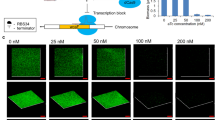Abstract
Inclusion complex between cyclodextrins (CDs) and bacterial signal molecules is responsible for inhibitory effects on quorum sensing (QS). Since many bacteria have QS system for controlling gene expression in response to cell population density by means of signal molecules, an intercept of the QS signal onto the CDs can be a general method to control transcription of the QS-regulated genes. The QS in the opportunistic pathogen Serratia marcescens could be artificially controlled by trapping the QS signal N-acylhomoserine lactones (AHLs) onto the CDs because AHLs are known to work as a common QS signal in gram negative bacteria. After S. marcescens was cultured in the presence of 10 mM 2−hydroxypropyl-β-CD (HP-β-CD), the relative prodigiosin production could be reduced to approximately 0.86. Nonspecific adsorption of AHLs onto the cellulose ether gel sheets was very little because the relative production of prodigiosin remained 0.95–1.00 after the immersion of the gel sheets in the liquid medium throughout the cell culture. Addition of both anionic carboxymethyl cellulose gel sheets and 10 mM HP-β-CD in the culture medium effectively controlled the relative prodigiosin production to approximately 0.56. This result suggested that the ionic interaction between acceptor molecules and the AHLs could stabilize the inclusion complex and then block the sequential QS-regulated process. Moreover, CD-immobilized polymer gel sheets have high potential for the QS regulation because HP-β-CD-immobilized hydroxypropyl cellulose or hydroxypropyl methyl cellulose gel sheets effectively controlled the prodigiosin production.
Similar content being viewed by others
References
Greenberg E.P., ASM News 63: 371 (1997)
Chen X., Schauder S., Poiter N., Dorsselaer A.V., Pelczer I., Bassler B.L., Hughson F.M., Nature 415: 545 (2002)
Roger S. Smith, Barbara Iglewski H., Curr. Opin. Microbiol. 6: 56 (2003)
Ikeda T., Bacterial Adherence Biofilm: 17: 117 (2003)
T. Ikeda, K. Kajiyama, T. Kita, N. Takiguchi, A. Kuroda, J.␣Kato, and H. Ohtake: Chem. Lett., 314 (2001)
Dong Y.-H., Wang L.-H., Xu J.-L., Zhang H.-B., Zhang X.-F., Zhang L.-H., Nature 411: 813 (2001)
T. Ikeda, T. Morohoshi, N. Kato, M. Inoyama, S. Nakazawa, K.␣Hiratani, T. Ishida, J. Kato, and H. Ohtake: Proc. 10th Asia Pacific Confederation of Chemical Engineering 2004, No. 390, 1 (2004)
Dauenhauer S.A., Hull R.A., Williams R.P., J. Bacteriol. 158: 1128 (1984)
Kato N., Gehrke S.H., Colloids Surf. B., Biointerfaces 38: 191 (2004)
Thomson N.R., Crow M.A., McGowman S.J., Cox A., Salmond G.P.C., Mol. Microbiol. 36: 539 (2000)
Slater H., Crow M., Everson L., Salmond G.P.C., Mol. Microbiol. 47: 303 (2003)
Acknowledgements
This work was partly supported by Grant of the Tokyo Ohka Foundation for the Promotion of Sciences and Technology, and the Japan Society for the Promotion of Science, Grant-in-aid for Scientific Research (C) (KAKENHI 16560681).
Author information
Authors and Affiliations
Corresponding author
Rights and permissions
About this article
Cite this article
Kato, N., Morohoshi, T., Nozawa, T. et al. Control of Gram-Negative Bacterial Quorum Sensing with Cyclodextrin Immobilized Cellulose Ether Gel. J Incl Phenom Macrocycl Chem 56, 55–59 (2006). https://doi.org/10.1007/s10847-006-9060-y
Received:
Accepted:
Published:
Issue Date:
DOI: https://doi.org/10.1007/s10847-006-9060-y




